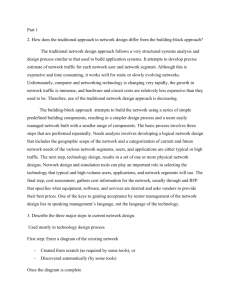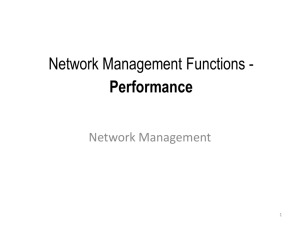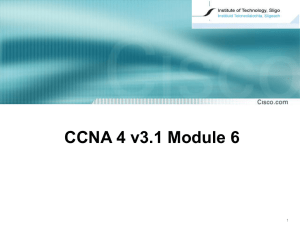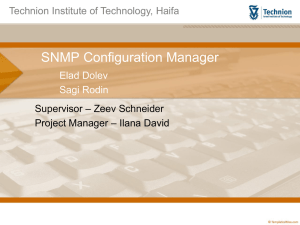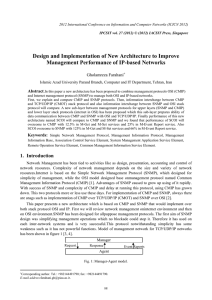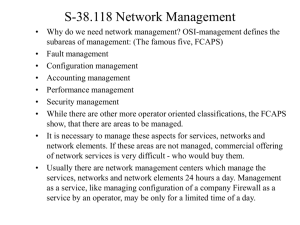Network Management Definition
advertisement
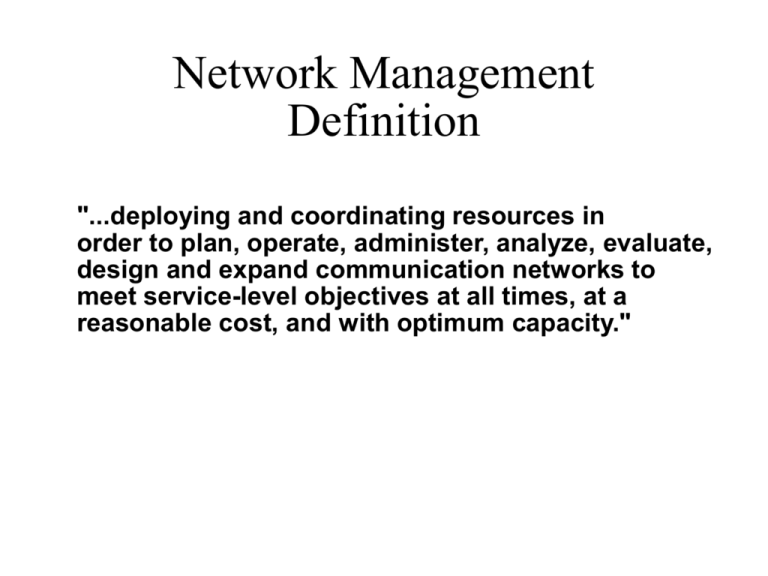
Network Management
Definition
"...deploying and coordinating resources in
order to plan, operate, administer, analyze, evaluate,
design and expand communication networks to
meet service-level objectives at all times, at a
reasonable cost, and with optimum capacity."
Network Management
Functional Areas
• Fault Management
detect -- diagnose -- repair
•Configuration/Name Mgmt
a database problem...
•Performance Mgmt
measure and predict
•Accounting Mgmt
look at individual usage
•Security Mgmt
access control and encryption
Management Protocols
• SNMP - Simple Network Management
Protocol
– Internet
• CMIP - Common Management Information
Protocol
– ISO
• TMN - Telecommunications Management
Network
– ITU-T
Management Protocols
Philosophy
• SNMP - Simple Network Management
Protocol
– keep it simple! (cf the Internet toaster)
• CMIP - Common Management Information
Protocol
– the bazaar: whatever you want
• TMN - Telecommunications Management
Network
– actually a separate network specification
SNMP vs CMIP {round 1}
SNMP
CMIP
Requirements from
various vendors and
user communities
ISO Management Overview
Fault
Configuration Performance Security
Accounting
Management Management Management Management Management
System Management Functions
Object Mgmt Alarm Mgmt Event Report Mgmt Workload Monitoring
State Mgmt Log Control Security Alarm
Security Reporting
Measurement Summarization
Bill Verification
Billing
Resource Utilization
Test Mgmt
Relation Mgmt
CMISE Services
Initialize Event Report
Set Get Delete Cancel
Terminate
Action Create Abort
Confirmed Event Report Confirmed Get
SNMP Architecture
• Keep the agent as simple as possible
• Support remote management operations to
the fullest extent possible
• Plan for future additions & expansion
• Be independent of specific hosts or devices
• Operate at the Application level
Internet Management Model
Agent
Managed
Entities
Network
Management
Proxy
Agent
Managed
Entities
SNMP
• Intersection of vendor/user requirements
• Few ‘verbs’:
–
–
–
–
get / get-next
get-bulk {SNMPv2}
set
trap
• Polled, Master-Slave, Request-Response
SNMP Format
• <header><verb><value><variable>[<verb><value><varia
ble>]
• ASN.1 subset to describe value format
• MIB-II{Management Information Base} to
identify variables
• UDP as a Transport layer
• Now out! SNMPv2
The MIB
• Standard set of data for managing network
devices
• Variable names are part of the ISO/CCITT
object identifier namespace
• Provides globally unique identifiers
• Variables governed by Structure of
Management Information (SMI)
specification
Accessing MIB Data
• SNMP Communities
• SNMP Views
• SNMP Authentication
Abstract Syntax Notation 1
(ASN.1)
•
•
•
•
•
Data Structures
Abstract Syntax
Transfer Syntax
International Standard 8825
Notation used to encode, transfer and
decode data structures across a wide range
of applications
• Both connection-oriented and
Example SNMP PDU using
ASN.1
SEQUENCE len=41 INTEGER
len=1 vers=0
30
29
02
01
00
string len=6 p
u
b
l
i
c
04 06
70
75
62
6C
69
63
getreq. len=28 INTEGER len=4 -------request ID--------------A0 1c
02
04
05
AE
56
02
INTEGER len=1 status INTEGER len=1 error index
02
01
00
02
01
00
SEQ. len=14 SEQ len=12 objectid
len=8
30 0E 30
0C
06
08
SNMP vs SNMPv2
• History in Brief
• More features (more complex)
• BIG increase in security
– authentication and integrity
– access controls
– security and privacy
• Better access controls in Views
• Trap confirmations
Enterprise Architecture
• SNMP is designed for simple, manager-toagent communications
• CMIP is complex and bulky, by complete
• Most Enterprise networks can’t be managed
directly from a single place
Enterprise Management
CMIP
Managers
SNMP
Managers
Local
Networks
Separate
Organization
Management Tools
• Packet Analyzer
• Media Analyzers (TDR, OTDR, BER
Tester)
• RMON devices
• Hosts (?)
Software Tools
• Hosted on PCs
• Hosted on Unix Workstations
• Commercial Packages
Decent Books
• Network Management Standards 2d ed
– Uyless Black
• The Simple Book, 2d ed
– Marshall T. Rose
• Communication Networks Management, 2d
ed
– Kornel Terplan
• Internetworking with TCP/IP, Vol I, 3d ed
